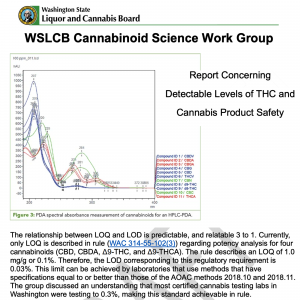The WSLCB Cannabinoid Science Work Group planned to publicly review their draft recommendations on quantifying “any detectable amount of THC.”
Here’s a look at cannabis-related policymaking events on the calendar in the week ahead.
Monday October 2nd
At publication time, no cannabis-related policymaking events were scheduled.
Tuesday October 3rd
WSLCB - Board Caucus
On Tuesday at 10am PT, the weekly Washington State Liquor and Cannabis Board (WSLCB) Board Caucus was scheduled to recur.
- [ Event Details ]
- At the caucus on Tuesday September 26th, board members heard a few rulemaking updates before reflecting on the development of the Research Unit and the impending departure of Kathy Hoffman, a rulemaking and research leader at WSLCB, in mid-October.
- At the board meeting on Wednesday September 27th, an update on retail social equity licensing preceded public comments that ranged from praise of the process to accusations of corruption and conflicts of interest.
Wednesday October 4th
At publication time, no cannabis-related policymaking events were scheduled.
Thursday October 5th
WSLCB - Work Group - Cannabinoid Science - Public Meeting
On Thursday at 10am PT, the WSLCB Cannabinoid Science Work Group (WSLCB - Work Group - Cannabinoid Science) was scheduled to convene.
- [ Event Details ]
- The Cannabinoid Science Work Group last convened publicly on August 3rd. Members have been convening privately in two sub-groups for several months.
- During caucus the prior week, Research Manager Kathy Hoffman—who organized and led the work group—indicated members planned to review the final draft of her requested report dealing with “detectable levels of THC” and “pathways to implement [SB] 5367.”
- The executive summary of the draft report indicated:
- “The subgroup critically reviewed, compared, and contrasted materials pertaining to cannabis product testing and production standards from several resources, including but not limited to the Association of Analytical Chemists (AOAC), the American Society for Testing and Materials (ASTM), and the United States Pharmacopeia Food Chemical Codex (USP- FCC). The CSWG asserts that the relationship between the limit of quantification (LOQ) and limit of detection (LOD) is predictable, and relatable 3 to 1. Currently, only LOQ is described in rule (WAC 314-55-102(3)) regarding potency analysis for four cannabinoids (CBD, CBDA, Δ9-THC, and Δ9-THCA). The rule describes an LOQ of 1.0 mg/g or 0.1%. Therefore, the LOD corresponding to this regulatory requirement is 0.03%. This limit can be achieved by laboratories that use methods that have specifications equal to or better than those of the AOAC methods. The group discussed an understanding that most certified cannabis testing labs in Washington were testing to 0.3%, making this standard achievable in rule to implement E2SSB 5367. The group also discussed potential variances in detectable amounts of THC across product type and offers ranges of detection based on product type, along with suggestions and considerations for cannabis product safety.”
- Additionally, Hoffman indicated, “We were sort of thinking that the cannabinoids work group would…expire on or about the last meeting in December,” but all members of a subgroup were amenable to “continuing the work” in 2024 under the leadership of WSLCB Operational Research Specialist Sarah Okey, and with the support of board members.
Friday October 6th
WSLCB - Focus Group - Product Samples
On Thursday at 10am PT, WSLCB staff planned to host a focus group on the Product Samples rulemaking project.
- [ Event Details, Rulemaking Project ]
- The announcement indicated, “The Liquor and Cannabis Board (LCB) invites cannabis licensees and other interested parties to join in collaborative discussions regarding cannabis samples rulemaking. The discussion will cover alternative regulatory approaches for conducting vendor and educational sampling activities that were developed using responses from cannabis licensee surveys.”
